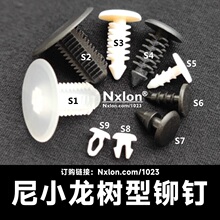Split Pin
©Nxlon.com D/T:

The split pin is a commonly used mechanical connection and anti-loosening part. The following is a detailed introduction to the split pin:
Definition and Structure of the Split Pin
The split pin is a "U"-shaped metal pin, usually made of low-carbon steel or medium-carbon steel. Some are made of stainless steel to adapt to special environments. One end of it has a small hole, which is used to pass through the hole at the tail of a bolt or nut, and the other end can be opened to form an opening to prevent the connected parts from loosening.
Features of the Split Pin
Good Anti-loosening Performance: It can effectively prevent the loosening of connecting parts such as nuts and bolts under vibration or impact loads, ensuring the reliability of the connection.
Simple Structure: With a simple shape, the manufacturing process is relatively easy, and the cost is low.
Easy Installation: No special tools are required. Just insert the split pin into the corresponding hole and open it to complete the installation.
Reusable: After the connected parts are disassembled, the split pin can usually be reused if it is not damaged.
Manufacturing Standards of the Split Pin
The national standard is GB/T 91-2000 "Split Pins", which stipulates the dimensions, tolerances, materials, surface treatments, etc. of the split pin. For example, it clarifies the dimensional parameters corresponding to different nominal specifications, the mechanical property requirements of the materials, and that the surface should be subjected to galvanized passivation or oxidation treatment, etc.
Materials and Surface Treatments of the Split Pin
Commonly Used Materials: Generally, carbon steels such as Q215 and Q235 are used. When a higher corrosion resistance is required, stainless steel materials such as 1Cr18Ni9Ti are selected.
Surface Treatments: Common ones include galvanizing, cadmium plating, etc., which can improve the corrosion resistance of the split pin and extend its service life. In addition, there is also oxidation treatment, which forms an oxide film on the surface to play a certain anti-rust role.
Application Fields of the Split Pin
Mechanical Field: Widely used in the connection parts of various mechanical equipment, such as gearboxes, engines, cranes, etc., to prevent the loosening of connecting parts such as bolts and nuts.
Automotive Industry: Often used in the connection of parts such as the chassis, engine, and body of automobiles to ensure the safe and reliable connection of various components during the driving process of the automobile.
Railway Transportation: Used in the connection of railway tracks, the bogies of vehicles, etc., to ensure the stability of the railway system under high-speed operation and vibration conditions.
Construction Machinery: In the connection parts of equipment such as tower cranes and concrete mixers, the split pin plays an important anti-loosening role, ensuring the safe operation of the equipment.
Marking Method of the Split Pin
The marking content includes information such as the product name, nominal specification, length, material, and surface treatment. For example, the marking "Split Pin GB/T 91 5×50 Q235 - Zn" indicates a split pin with a nominal specification of 5mm, a length of 50mm, a material of Q235 steel, and a surface treatment of galvanizing.
Purchase Precautions for the Split Pin
Size Matching: According to the hole diameter and slot width of the actually used connecting parts such as bolts and nuts, select a split pin with an appropriate nominal specification to ensure a tight fit.
Material Selection: Select a split pin with an appropriate material according to the corrosion degree, temperature, and other conditions of the use environment. For example, in a humid environment, a split pin made of stainless steel should be selected.
Quality Inspection: Check the appearance of the split pin, which should have no defects such as cracks, burrs, and deformations. At the same time, check whether its hardness and toughness meet the requirements, and a preliminary judgment can be made through a simple bending test.
Installation and Maintenance of the Split Pin
Installation: First, insert the split pin into the hole at the tail of the bolt or nut, and then use a tool to open the tail of the split pin so that the opening angle meets the requirements. Generally, the opening angle is 60° - 90°. When installing, ensure that the split pin is completely inserted into the hole and the opening is uniform and symmetrical.
Maintenance: Regularly check the status of the split pin. If the split pin is found to be loose, deformed, corroded, or damaged, etc., it should be replaced in a timely manner. When the equipment is overhauled or maintained, the split pin should also be checked and maintained to ensure that it is always in good working condition.
尼小龙塑料螺丝-塑料螺母-尼龙垫圈-塑料铆钉
绝缘塑料SS扣式PC板隔离柱
订购链接:Nxlon.com/1009
尼小龙SS隔离柱是一种PC板隔离柱,由塑料PA66材质制成 。从外观上看,呈圆柱状,颜色通常为白色、黑色,柱体一端有开口结构设计 ,整体造型简洁规整。标注显示其柱内没有螺纹,区别于一些带有螺纹的隔离柱产品。
塑料铆钉-尼小龙树形铆钉
订购链接:Nxlon.com/1023
绝缘塑料树形铆钉又称倒齿形塑料铆钉或圣诞树型塑料铆钉品名:树型塑料铆钉;材质:尼龙 Nylon;适合孔径:5.5mm-6.5mm;适合板厚:2.0mm-10.0mm
绝缘尼龙垫圈塑料垫片
订购链接:Nxlon.com/1010
绝缘尼龙垫圈塑料垫片是以尼龙为材质的平垫圈,在电子、机械等领域应用广泛,尼龙垫圈材质:尼龙66,颜色:黑色;规格:公称内径*公称外径*公称厚度
R3560-塑料铆钉-尼龙铆钉
订购链接:Nxlon.com/3560
R3560-塑料铆钉-尼龙铆钉塑料铆钉-尼龙铆钉-汽车塑胶铆钉-尼小龙尼龙铆钉R2.6R3.5R4R5塑胶柳钉子母铆钉快捷紧固件塑料卡扣。
R3055-塑料铆钉-尼龙铆钉
订购链接:Nxlon.com/3055
R3055-塑料铆钉-尼龙铆钉塑料铆钉-尼龙铆钉-汽车塑胶铆钉-尼小龙尼龙铆钉R2.6R3.5R4R5塑胶柳钉子母铆钉快捷紧固件塑料卡扣。
塑料芭蕾铆钉-尼龙宝塔卡扣
订购链接:Nxlon.com/1026
国标塑料铆钉芭蕾铆钉材质:POM、PC等;颜色:白色、黑色、透明;R型铆钉,芭蕾铆钉与宝塔铆钉起源于广东中山,它们都是一种简易铆接的塑料卡扣; 利用塑料的记忆性紧固两较薄的面板,铆定后可以再次取下,可重复使用。
内3.2外7.0白色塑料直通柱ABS隔离柱
订购链接:Nxlon.com/1012
内3.2外7.0白色塑料直通柱ABS隔离柱是一种以ABS(丙烯腈 - 丁二烯 - 苯乙烯共聚物 )为材质的PC板隔离柱。
塑料螺丝保护套-螺母保护帽
订购链接:Nxlon.com/1035
塑料螺丝帽保护套-塑料螺母保护帽M8M10六角塑料螺母保护帽外六角塑料螺丝盖罩螺栓螺丝装饰防尘套,尼小龙螺母保护帽材质:聚丙烯 Polypropylene,型号:S-12-PP, S-13-PP, S-14-PP, S-16-PP, S-17-PP









